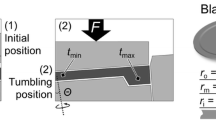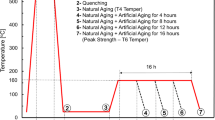Abstract
Sheet-bulk metal forming processes combine conventional sheet forming processes with bulk forming of sheet semi-finished parts. In these processes the sheets undergo complex forming histories. Due to in- and out-of-plane material flow and large accumulated plastic strains, the conventional failure prediction methods for sheet metal forming such as forming limit curve fall short. As a remedy, damage models can be applied to model damage evolution during those processes. In this study, damage evolution during the production of two different toothed components from DC04 steel is investigated. In both setups, a deep drawn cup is upset to form a circumferential gearing. However, the two final products have different dimensions and forming histories. Due to combined deep drawing and upsetting processes, the material flow on the cup walls is three-dimensional and non-proportional. In this study, the numerical and experimental investigations for those parts are presented and compared. Damage evolution in the process chains is simulated with a Lemaitre damage criterion. Microstructural analysis by scanning electron microscopy is performed in the regions with high mechanical loading. It is observed that the evolution of voids in terms of void volume fraction is strongly dependent on the deformation path. The comparison of simulation results with microstructural data shows that the void volume fraction decreases in the upsetting stage after an initial increase in the drawing stage. Moreover, the concurrent numerical and microstructural analysis provides evidence that the void volume fraction decreases during compression in sheet-bulk metal forming.













Similar content being viewed by others
References
Merklein M, Tekkaya AE, Brosius A, Opel S, Koch J (2011) Overview on sheet-bulk metal forming processes. In: Proceedings of the 10th international conference on technology of plasticity, pp 1109–1114
Merklein M, Allwood JM, Behrens BA, Brosius A, Hagenah H, Kuzman K, Mori K, Tekkaya AE, Weckenmann A (2012) Bulk forming of sheet metal. Ann CIRP 2(61):725–745
Merklein M, Koch J, Opel S, Schneider T (2011) Fundamental investigations on the material flow at combined sheet and bulk metal forming processes. Ann CIRP 1(60):283–286
Hosford WF, Caddell RM (1993) Metal forming—mechanics and metallurgy, 2nd edn. Prentice-Hall, Englewood Cliffs
Soyarslan C, Faßmann D, Plugge B, Isik K, Kwiatkowski L, Schaper M, Brosius A, Tekkaya AE (2011) An experimental and numerical assessment of sheet-bulk formability of mild steel DC04. J Manuf Sci Eng 133(6):1–9
Oyachi Y, Allwood JM (2011) Characterizing the class of local metal sheet thickening processes, steel research international, special edition. 10th International conference on technology of plasticity, ICTP 2011, pp 1025–1030
Li Y, Luo M, Gerlach J, Wierzbicki T (2010) Prediction of shear-induced fracture in sheet metal forming. J Mater Process Technol 210:1858–1869
Lemaitre J (1992) A course on damage mechanics. Springer, Berlin
Badreddine H, Saanouni K, Dogui A (2010) On non-associative anisotropic finite plasticity fully coupled with isotropic ductile damage for metal forming. Int J Plast 26:1541–1575
Ladevèze P, Lemaitre J (1984) Damage effective stress in quasi-unilateral condition. IUTAM Congress, Lyngby
Hubert C, Dubar L, Dubar M, Dubois A (2011) Finite element simulation of the edge-trimming/cold rolling sequence: analysis of edge cracking. J Mater Process Technol 212(5):1049–1060
Mashayekhi M, Torabian N, Poursina M (2010) Continuum damage mechanics analysis of strip tearing in a tandem cold rolling process. Simul Model Pract Theory 19(2):612–625
Gurson AL (1977) Continuum theory of ductile rupture by void nucleation and growth: part I—yield criteria and flow rules for porous ductile media. J Eng Mater Technol 99(1):2–15
Schneider T, Vierzigmann U, Merklein M (2014) Analysis of varying properties of semi-finished products in sheet-bulk metal forming of functional components. In: Yoon JW, Stoughton TB, Rolfe B, Beynon JH, Hodgson P (Hrsg.): NUMISHEET 2014: The 9th international conference and workshop on numerical simulation of 3D sheet metal forming processes, pp 930–933
Naunheimer H, Bertsche B, Ryborz J, Novak W (2011) Automotive transmissions: fundamentals, selection, design and application, 2nd edn. Springer, Berlin
Behrens BA, Bouguecha A, Vucetic M, Hübner S, Rosenbusch D, Koch S (2015) Numerical and experimental investigations of multistage sheet-bulk metal forming process with compound press tools. In: ESAFORM 2015—key engineering materials (Hrsg.): 18th international ESAFORM conference on material forming, vol 651, pp 1153–1158
Isik K, Soyarslan C (2013) Continuum damage mechanics (CDM) based local approach to the sheet-bulk metal formability prediction. Adv Mater Res 769:205–212
Lemaitre J, Desmorat R (2005) Engineering damage Mechanics. Springer, Berlin
Behrens BA, Voges-Schwieger K, Bouguecha A, Mielke J, Vucetic M (2012) Material characterization for sheet-bulk metal forming. Key Eng Mater 504–506:1029–1034
Acknowledgments
The authors gratefully acknowledge funding by the German Research Foundation (DFG) within the scope of the Transregional Collaborative Research Centre on sheet-bulk metal forming (SFB/TR 73) in the subprojects A1 “Process combination for manufacturing of teethed, thin-walled functional components out of tailored blanks”, A7 “Improvement of combined cutting and deep drawing processes by means of overlaying dynamic process forces”, C4 “Analysis of load history dependent evolution of damage and microstructure for the numerical design of sheet-bulk metal forming processes”.
Author information
Authors and Affiliations
Corresponding author
Rights and permissions
About this article
Cite this article
Isik, K., Gerstein, G., Schneider, T. et al. Investigations of ductile damage during the process chains of toothed functional components manufactured by sheet-bulk metal forming. Prod. Eng. Res. Devel. 10, 5–15 (2016). https://doi.org/10.1007/s11740-016-0656-9
Received:
Accepted:
Published:
Issue Date:
DOI: https://doi.org/10.1007/s11740-016-0656-9




